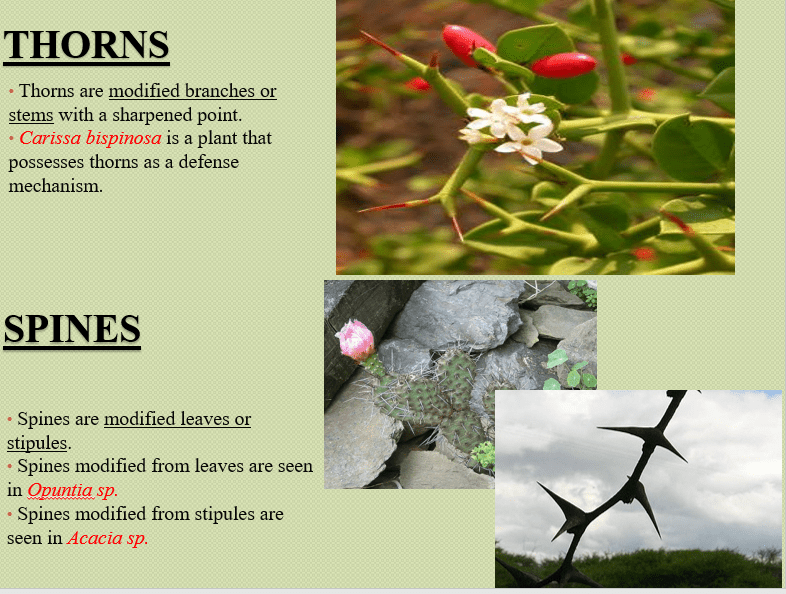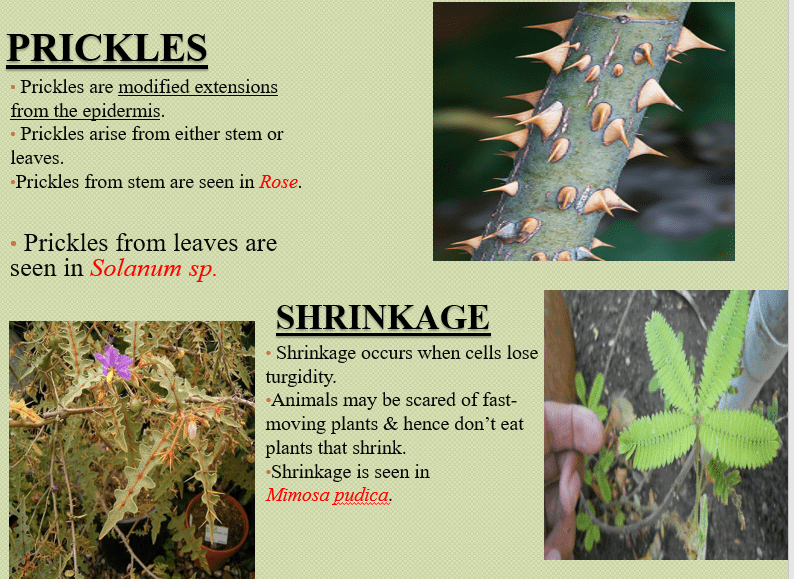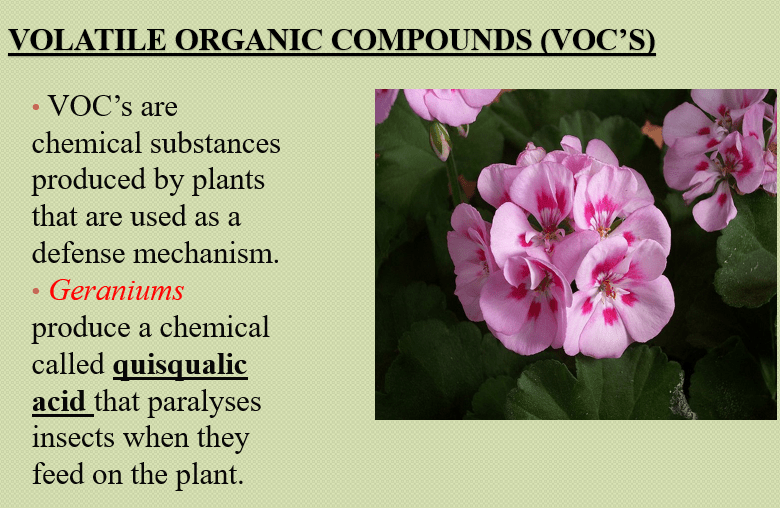Biotic stress: PLANT PATHOGEN INTERACTIONs
Mode of Infection
- Virus
- Bacteria
- Fungi
(A) Mechanical Forces Exerted on Host Tissues by Pathogens
Viruses are usually introduced directly through the plant cells by insects (BPH, Aphids).
Natural openings (stomata)
wounding site
Therefore they do not exert mechanical forces to enter in the host.
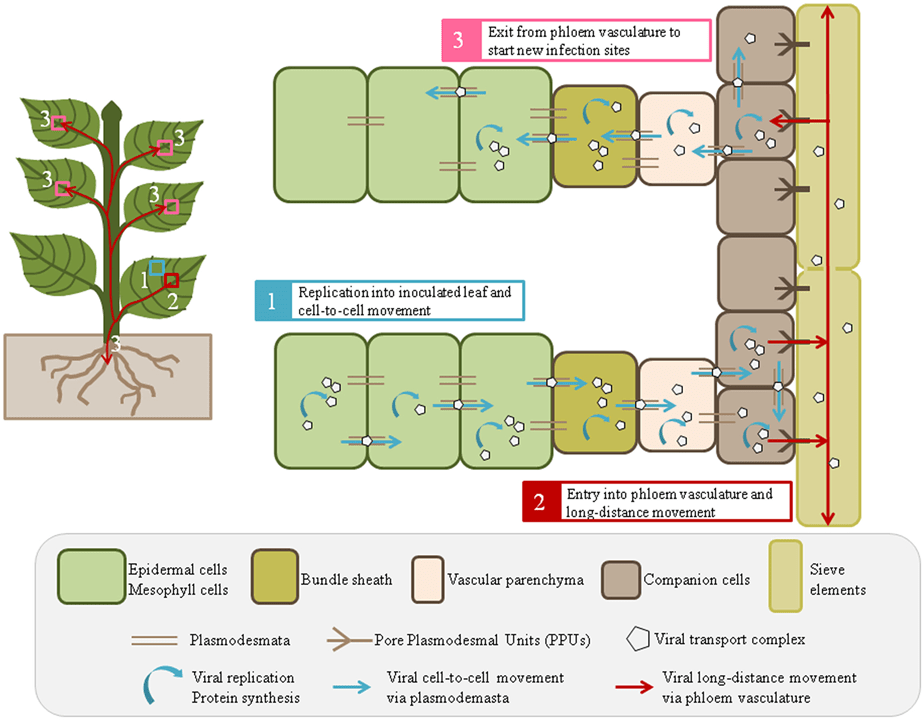
Fungus: Mode of infection
Many fungi are known to apply mechanical forces on the plant they are about to attack.
When fungal spore lands on a plant surface, and contact is established, diameter of the tip of the hypha or radical in contact with the host increases and forms the flattened, bulb-like structure called the Appressorium.
This increases the area of adherence between the two organisms and securely fastens the pathogen to the plant.
From the appressorium, a fine growing point, called the Penetration Peg arises and advances into and through the cuticle and the cell wall.
The infection process in fungal and oomycete pathogens.
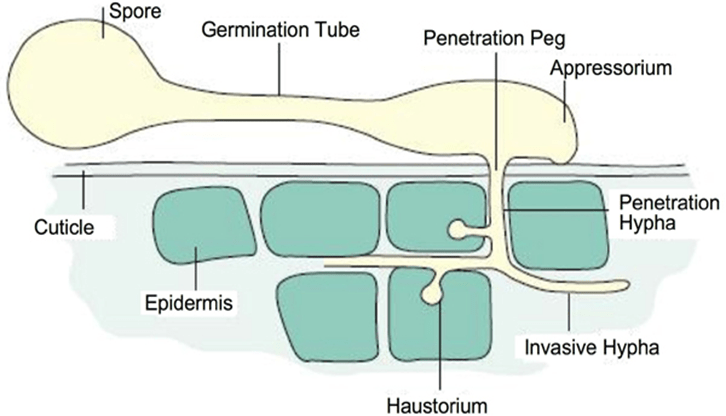
(B) Chemical Weapons of Pathogens
Some pathogens in plant are largely chemical in nature. Therefore, the effects caused by pathogens on plants are almost entirely the result of biochemical reactions taking place between substances (Hydrolytic enzymes) secreted by the pathogen and those present in or produced by the plant.
The main groups of substances secreted by pathogens in plants that seem to be involved in production of disease either directly or indirectly, are
Enzymes
Toxins
Growth regulators
Polysaccharides (plugging substances).
Enzymes….. Plant cuticle/epidermal layer
Toxins seem to act directly on protoplast components and interfere with the permeability of its membrane and with its functions.
Growth regulators exert a hormonal effect on the cells and increase or decrease their ability to divide and enlarge.
Polysaccharides seem to play a role only in the vascular diseases, in which they interfere passively with the translocation of water in the plants.
(i) Enzymes
(A) Cutinases:
Cutin is the main component of the cuticle. The upper part of the cuticle is admixed with waxes, whereas its lower part in the region where it merges into the outer walls of epidermal cells, is admixed with pectin and cellulose.
Cutinases break down cutin molecules and release monomers as well as oligomers of the component fatty acid derivatives from the insoluble cutin polymer e.g. Fusarium spp. and Botrytis cinerea.
(B) Pectinases:
Pectin substances constitute the main components of the middle lamella i.e. the intercellular cement that holds in place the cells of plant tissues. Several enzymes degrade pectic substances and are known as pectinases or pectolylic enzymes.
(C) Cellulases:
Cellulose is also a polysaccharide, but it consists of chains of glucose (1-4) β-D-glucan molecules. Saprophytes fungi, mainly certain groups of basidiomycetes, and to a lesser degree, saprophytic bacteria cause the breakdown of most of the cellulose
In living plant tissues, however, cellulolytic enzymes secreted by pathogens play a role in the softening and disintegration of cell wall material.
(ii) Microbial toxins
Toxins are metabolites that are produced by invading microorganisms and act directly on living host protoplast, seriously damaging or killing the cells of the plant.
Some toxins act as a general protoplasmic poisons and affect many species of plant representing different families. Others are toxic to only a few plant species or varieties and are completely harmless to others. Many toxins exist in multiple forms that have different potency.
◦(A) Non-host specific toxin
◦(B) Host specific toxin
(A) Non-Host Specific Toxin Or
Non-Host-selective Toxins
(1) Tab-toxin:-
It is produced by the bacterium Pseudomonas syringae pv tabaci which causes the wildfire disease of tobacco, bean and soybean and by other pathovars of P. syringae such as those occurring on oats, maize and coffee.
(2) Phaseolo-toxin:-
It is produced by the Pseudomonas syringae pv phaseolicola, the cause of halo blight of bean and some other legumes.
(3) Ten-toxin:-
It is produced by the fungus Alternaria alternata which causes spots and chlorosis in plants by many species.
(4) Cercosporin–
It is produced by the fungus Cercospora and by several other fungi. It causes damaging leaf spot and blight diseases of many crop plants such as Cercospora leaf spot of zinnia and grey leaf spot of corn.
(B) Host Specific or Host-selective Toxins
1.Victorin or HV toxin – It is produced by the fungus Cochliobolus Victoriae. This fungus infects the basal portions of susceptible oat plants and produces a toxin that is carried to the leaves, causes a leaf blight and destroys the entire plant.
2.T-toxin- It is produced by race T of Cochliobolus heterostrophus, the cause of southern corn leaf blight.
3.HC-toxin- It is produced by Race 1 of C. carbonum causing northern leaf spot and ear rot disease in maize.
(iii) Growth Regulators
(a)Auxins-
It occurs naturally in plants as indole-3-acetic acid (IAA). Increased IAA levels occur in many plants infected by fungi, bacteria, viruses, and nematodes, although some pathogens seem to lower the auxin level of the host e.g Ustilago maydis causative organism of corn smut.
(b) Cytokinins–
Cytokinin activity increases in clubroot galls, in smut and rust infected bean leaves. it is partly responsible for several bacterial galls of leafy gall disease of sweet pea caused by bacterium Rhodococus fasciens.
(c) Gibberellins-
High level of gibberellins due to foolish seedling diseases of rice, in which rice seedlings infected with the fungus Gibberella fujikuroi grow rapidly and become much taller than healthy plants is apparently the result, to a considerable extent at least, of the gibberellins secreted by the pathogen.
(d) Ethylene –
In the banana fruit infection with Ralstonia solanacearum, the ethylene content increases proportionately with the (premature) yellowing of the fruits, whereas no ethylene can be detected in the healthy fruits.
(iv) Polysaccharides
Fungi, bacteria, nematodes and possibly other pathogens constantly release varying amounts of mucilaginous substances that coat their bodies and provide the interface between the outer surface of the microorganism and its environment.
The role of the slimy polysaccharides in plant disease appears to be particularly important in wilt diseases caused by pathogens that invade the vascular system of the plant.
Large polysaccharide molecules released by the pathogen in the xylem may be sufficient to cause a mechanical lockage of vascular bundles and thus initiate wilting.
Changes in Plant Metabolism After Infection
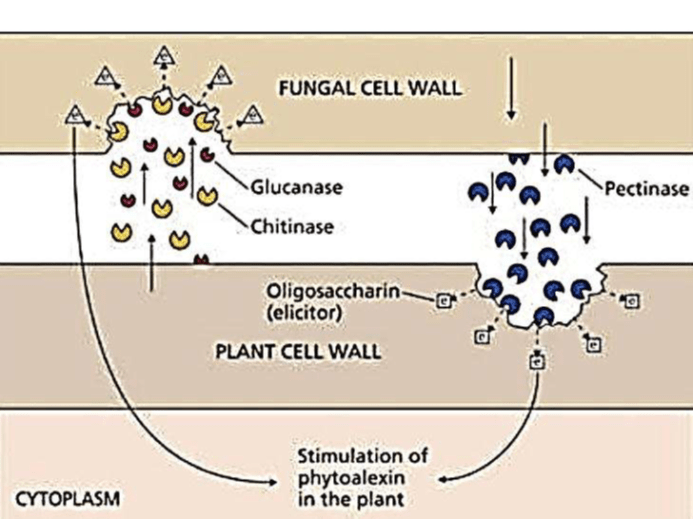
Plant defense mechanisms
Plant defense
Constitutive
Cell walls
Waxy epidermal cuticle
Bark
Thorns
Spine
Inducible
Toxic chemicals
Pathogen degrading enzymes
Deliberate cell suicide
Systemic resistance
1. Constitutive defense mechanism
- Plants need to protect themselves from various threats. Hence, some plants have modified parts that are used for defense.
- These defense mechanisms are used to protect plants from herbivorous, animals also from insects laying eggs on the plant.
Types of Defense Mechanisms
1.Thorns
2.Spines
3.Prickles
4.Shrinkage
5.Milky Latex
6.Trichomes
7.Volatile Organic Compounds (VOC’s)
